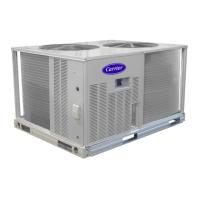14
Suction Riser —
A suction riser condition exists when the outdoor unit is
located above the indoor (evaporator) unit and suction
vapor must flow vertically up to return to the compressor.
Oil return is a conce rn when the suction tube siz e is too
large to produc e the minimum refrigerant velocity to
ensure oil return at minimum load conditions.
Check Table 7 for maximum suction tube size for 38AU
units at minimum load conditions. Consider suction speed
riser (reduced tube size for vertical segment only) or
double suction riser arrangement if t he proposed suction
tube size does not provide necessary minimum flowrates
for this riser.
Table 7 –
38AU Maximum Suction Pipe Size
Model: Unit Size Maximum Tube Size
38AUZ 07 1
3
/
8
08 1
5
/
8
38AUD 12 1
3
/
8
14 1
3
/
8
Vertical Separation (outdoor unit above indoor unit) –
Vertical elevation difference of 60 m (200 ft) is permitted
when the outdoor unit (38AUZ or 38AUD) is located
above the indoor unit.
Insulate Suction Lines —
Apply closed-cell tubular insulation to all suction lines
betwee n evaporator coil connection and 38AU unit’s
suction service valve.
Hot Gas Bypass —
Hot gas bypass, if used, should be introduced before the
evapora tor. (A bypass route that also bypasses the
evapora tor circuit may lead to oi l trapping in the
evapora tor circuit during low load conditi ons and then to
oil slugging as evaporator load increases.) Model 38AU
units do not include a hot gas stub connection; a tee must
be field-supplied and installed in the compressor discharge
line. Run a
1
/
2
-in OD line between outdoor unit and
evaporator coil inlet. Install an Auxiliary Side Connector
at the evaporator between TXV and distributor (follow
instructions for the side connector part). Insulate the hot
gas line.
38AUD: Generally only one hot gas bypass system will be
applied on a two-circuit unit. Connect the hot gas bypass
system to Circuit 1 (first-on/last-off, connected to the
evaporator coil’s bottom circuit).
38AUD Piping Connections —
The 38AUD’s two circuits are designated Circuit 1 and
Circuit 2. Circuit 1 is controlled by the thermostat’s Y1
(or TC1) contact and will be the first circuit on and last
circuit off. Circuit 2 is controlled by the thermostat’s Y2
(or TC2) contact and this circuit is always the “lag”
circuit.
See Fig. 5 for location of Circuit 1 and Circuit 2 service
valve s and field piping connections. Circuit 1 is on the
right-hand side of the service valve compartment; Circuit
2isontheleft.
When a single piece evaporator coil with two separate
circuits is connected to a 38AUD, the lower coil circuit
should be connected to the 38AUD’s Circuit 1 so that the
evapora tor’s lower coil segment is first-on/last-off (to
avoid re-evaporation of c ondensate on dry lower coil
segments).
Circuit 1
Connections
Circuit 2
Connections
CKT
2
CKT
1
C10912
Fig. 5 -- 38AUD Service Valve Loc ations
Plan the Circuit 1 and Circuit 2 tubing segments carefully,
mark each segment and check constantly as piping
systems are assembled to avoid piping errors.
38AUD unit cannot be field-piped as a
single-circuit/tandem system.
Connecting 40RU to 38AUD: The 40RU fan coil in sizes
12, 14 and 16 is a face-split coil design that also has its
circuits designated as 1 and 2. See Fig. 6. Note that the
lower coil segment change s as the arrangement of the
40RU c hanges. In a vertical arrangement, the 40RU’s
lower coil segm ent is segment 2; t his segment should be
connected to the 38AUD’s Circuit 1. In a horizontal
arrange ment, the 40RU’s lower segment is now segment
1; this segment should be connected to the 38AUD’s
Circuit 1.
Note that refrigerant suction piping should be insulated.
40RU
Arrangement
Cooling
Stage
40RU Coil
Segment
Connect to
38AUD
Vertical
Y1
Y2
2
1
Circuit 1
Circuit 2
Horizontal
Y1
Y2
1
2
Circuit 1
Circuit 2
38AU

